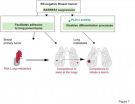(Press-News.org) Butterflies and dragonflies with lighter colours are out-competing darker-coloured insects in the face of climate change.
In a new study published in Nature Communications, scientists from Imperial College London, Philipps-University Marburg and University of Copenhagen have shown that as the climate warms across Europe, communities of butterflies and dragonflies consist of more lighter coloured species. Darker coloured species are retreating northwards to cooler areas, but lighter coloured species are also moving their geographical range north as Europe gets warmer.
For example, several Mediterranean dragonfly species have expanded their northern range and immigrated to Germany, such as the Southern Migrant Hawker (Aeshna affinis), the Scarlet Darter (Crocothemis erythraea) and the Dainty Damselfly (Coenagrion scitulum). In 2010, the Dainty Damselfly was also sighted in England for the first time in over 50 years. Butterfly species that thrive in warm climates, like the Southern Small White (Pieris mannii), have dispersed to Germany during the last ten years and are still continuing their northward shift.
As with lizards and snakes, the colour of an insect's body plays a key role in how they absorb energy from the sun, and is crucial in fuelling their flight as well as regulating their body temperature.
Dark-coloured insects are able to absorb more sunlight than light-coloured insects, in order to increase their body temperature, and are more likely to be found in cooler climates. In contrast, insects in hotter climates need to protect themselves against overheating. Light-coloured insects are more likely to be found in hotter climates as they can reflect the light to prevent overheating their body and be active for longer periods of time.
Carsten Rahbek, from the Department of Life Sciences at Imperial College London said: "For two of the major groups of insects, we have now demonstrated a direct link between climate and insect colour, which impact their geographical distribution."
"We now know that lighter-coloured butterflies and dragonflies are doing better in a warmer world, and we have also demonstrated that the effects of climate change on where species live are not something of the future, but that nature and its ecosystems are changing as we speak," concluded Professor Rahbek, who is also Director of the Center for Macroecology, Evolution and Climate at the University of Copenhagen. To identify whether colour lightness was correlated to temperature, the scientists combined digital image analysis, which scanned and measured colour values of butterfly and dragonfly wings and bodies, with distributional data which mapped where in Europe the species are found.
They looked at 366 butterfly species and 107 dragonfly species across Europe, and showed a clear pattern of light-coloured insects dominating the warmer south of Europe and darker insects dominating the cooler north.
To test whether a warming climate had caused any shifts, they looked at changes in species distributions over an 18-year period from 1988-2006. Results showed that on average insects were becoming lighter in colour, and that darker-coloured insects were shifting towards the cooler areas in Western margins of Europe, the Alps and the Balkans.
Research has previously suggested that climate change is having an impact on the distribution of species, but this study provides evidence of a direct link and confirms basic assumptions about how changes in the climate can affect patterns of biodiversity.
Lead author Dirk Zeuss from Philipps-University Marburg in Germany said: "When studying biodiversity, we lack general rules about why certain species occur where they do. With this research we've been able to show that butterfly and dragonfly species across Europe are distributed according to their ability to regulate heat through their colour variation. Until now we could only watch the massive changes in the insect fauna during the last 20 years. Now we have an idea of what could be a strong cause of the changes."
INFORMATION:
Contact:
Gail Wilson
Research Media Officer - Faculty of Natural Sciences
Tel: +44 (0)20 7594 6702
Duty press officer mobile: +44 (0)7803 886248
Email: gail.wilson@imperial.ac.uk
Notes to editors:
1. Zeuss, D et al. 2014. 'Global Warming favours light-coloured insects in Europe'. Nature Communications, 27 May 2014.
Under Strict Embargo - Tuesday 27 May 2014, 1600 BST / 1100 US Eastern Time
Once embargo has lifted, the paper can be downloaded at : http://dx.doi.org/10.1038/NCOMMS4874 Please note this is an uncorrected proof of the paper.
2. About Imperial College London
Consistently rated amongst the world's best universities, Imperial College London is a science-based institution with a reputation for excellence in teaching and research that attracts 14,000 students and 6,000 staff of the highest international quality. Innovative research at the College explores the interface between science, medicine, engineering and business, delivering practical solutions that improve quality of life and the environment - underpinned by a dynamic enterprise culture.
Since its foundation in 1907, Imperial's contributions to society have included the discovery of penicillin, the development of holography and the foundations of fibre optics. This commitment to the application of research for the benefit of all continues today, with current focuses including interdisciplinary collaborations to improve global health, tackle climate change, develop sustainable sources of energy and address security challenges.
In 2007, Imperial College London and Imperial College Healthcare NHS Trust formed the UK's first Academic Health Science Centre. This unique partnership aims to improve the quality of life of patients and populations by taking new discoveries and translating them into new therapies as quickly as possible.
Website: http://www.imperial.ac.uk
3. About the University of Copenhagen
With over 38,000 students and more than 9,000 employees, the University of Copenhagen is one of the largest institutions of research and education in the Nordic countries. Together, the six faculties offer over 200 programmes for study in health and medical sciences, humanities, law, natural science, social sciences, and theology. With its more than 530 years, the University of Copenhagen is also one of the oldest universities in Northern Europe.
The motivational force of the University's research activities is financially and politically independent - free basic research; however, specific collaborative endeavours with other institutions and companies also have a place among the countless research activities. The dissemination of knowledge and findings to other research environments and the general public is a natural element of the University's research efforts. http://www.ku.dk/english
4. About Philipps-Universität Marburg
Philipps-Universität Marburg is the oldest university in the world that was founded as a Protestant institution in 1527. It has been a place of research and teaching for nearly five centuries. Nowadays there are nearly 25,000 students studying in Marburg - 12 percent from all over the world. Almost all scientific disciplines, with the exception of the engineering sciences, are represented at Philipps-Universität Marburg. Its broad range of arts and humanities, and its experimentally challenging scientific work, constitute an ideal platform for interdisciplinary cooperation. The university relies on innovative teaching methods (with short course durations) and networked research, and offers a broad range of courses.
Light-colored butterflies and dragonflies thriving as European climate warms
2014-05-27
ELSE PRESS RELEASES FROM THIS DATE:
Climate warming favors light-colored insects in Europe
2014-05-27
Climate changeButterflies and dragonflies with a lighter shade of colour do better in warmer areas of Europe. This gives them a competitive advantage over the darker insects in the face of climate change. Changes in Europe's insect assemblages due to warming can already be seen for dragonflies, shows a study recently published in Nature Communications.
"When studying biodiversity, we lack general rules about why certain species occur where they do. With this research we've been able to show that butterfly and dragonfly species across Europe are distributed according to ...
Why are girl babies winning in the battle for survival?
2014-05-27
Sexual inequality between boys and girls starts as early as in the mother's womb – but how and why this occurs could be a key to preventing higher rates of preterm birth, stillbirth and neonatal death among boys.
A team from the University of Adelaide's Robinson Research Institute has been studying the underlying genetic and developmental reasons why male babies generally have worse outcomes than females, with significantly increased rates of pregnancy complications and poor health outcomes for males.
The results - published today in the journal Molecular Human Reproduction ...
Medical mechanics
2014-05-27
Removing a malignant tumor from the head of the pancreas is a risky and demanding operation. The surgeon must carefully navigate around the stomach, the gallbladder, the bile duct, lymph nodes, and several high-pressure blood vessels.
But an inexpensive device designed by Harvard engineering students and a surgeon at Beth Israel Deaconess Medical Center offers surgeons a confident grip throughout the delicate procedure. The gentle grasper, equipped with rubberized pressure sensors, has three slender fingers that can slip through a very small incision and tease cancerous ...
Just look, but don't touch: EMA terms of use for clinical study data are impracticable
2014-05-27
The European Medicines Agency (EMA) receives comprehensive clinical study data from drug manufacturers. These data form the basis for the decision on the approval of new drugs. To make this information available to researchers and decision-makers, EMA issued a draft policy in 2013 for the publication of clinical study data, in which extensive data transparency was planned.
Besides other interested parties, the German Institute for Quality and Efficiency in Health Care (IQWiG) was intensely involved in the subsequent consultations. The result of these consultations is ...
The future of sweet cherry in Australia
2014-05-27
AUSTRALIA -- Predicted variations in global climates have fruit producers trying to determine which crops are best suited to weathering future temperature changes. Extreme high-temperature events are expected to become more frequent, and predictive models suggest that the global mean surface air temperature will rise by as much as two degrees by the middle of the 21st century. Higher temperatures could have an impact on the duration of critical "winter chill" periods needed for successful fruit production, potentially altering growing strategies. According to the authors ...
Differences in phenolic makeup of indigenous rose species and modern cultivars
2014-05-27
LJUBLJANA, SLOVENIA – The leaves and petals of roses are valued for their medicinal and aesthetic uses around the world. A new study identified specific phenolic compounds found in the petals of indigenous rose species and compared them with the phenolic profiles of modern rose cultivars to determine differences in the makeup of roses traditionally used for medicinal purposes and those varieties cherished for aesthetic qualities. According to the results, distinct differences exist in the distribution of leaf phenolic compounds, especially between indigenous rose species ...
Researchers identify a new suppressor of breast metastasis to the lung
2014-05-27
A study published today in EMBO Molecular Medicine reveals that the loss of function of the gene RARRES3 in breast cancer cells promotes metastasis to the lung.
The research, headed by Roger Gomis, ICREA Professor at the Institute for Research in Biomedicine (IRB Barcelona), is the result of a collaboration between two IRB labs and Joan Massagué, at the Memorial Sloan Kettering Cancer Center in New York.
The scientists demonstrate that RARRES3 is suppressed in estrogen receptor-negative (ER-) breast cancer tumours, thus stimulating the later invasion of the cancer cells ...
The science of school lunch
2014-05-27
In terms of ambience, Charlotte Central's cafeteria is -- well, conjure up your own elementary school lunch experience. There's more than one reason to run to recess. But on a recent visit to observe a group of researchers from UVM's Johnson Lab, the lunch ladies were serving up something more likely to be found on a restaurant menu: risotto with mushrooms and peas. It's the result of a host of programs by schools around Vermont to offer more tempting choices -- with locally sourced ingredients when possible, including herbs and vegetables from the playground garden -- ...
New University of Colorado study illuminates how cancer-killing gene may actually work
2014-05-27
Scientists armed with a supercomputer and a vast trove of newly collected data on the body's most potent "tumor suppressor" gene have created the best map yet of how the gene works, an accomplishment that could lead to new techniques for fighting cancers, which are adept at disabling the gene in order to thrive.
Scientists from the University of Colorado Cancer Center and the University of Colorado Boulder used a new technology to tease out how the p53 gene—which is responsible for recognizing damaged DNA in cells and then marking them for death—is actually able to suppress ...
Why retailers need to pay attention to the smell of their stores
2014-05-27
This news release is available in French. Montreal, May 27, 2014 — Retail stores overflowing with merchandise can make consumers feel claustrophobic rather than ready to spend. But the recent move towards open, minimally stocked spaces can leave them feeling just as anxious.
The solution to this shopping conundrum may be smell, as new research from Concordia University shows.
In a study recently published in the American Journal of Business, researchers from the university's John Molson School of Business (JMSB) suggest that, when diffused in retail environments, ...



